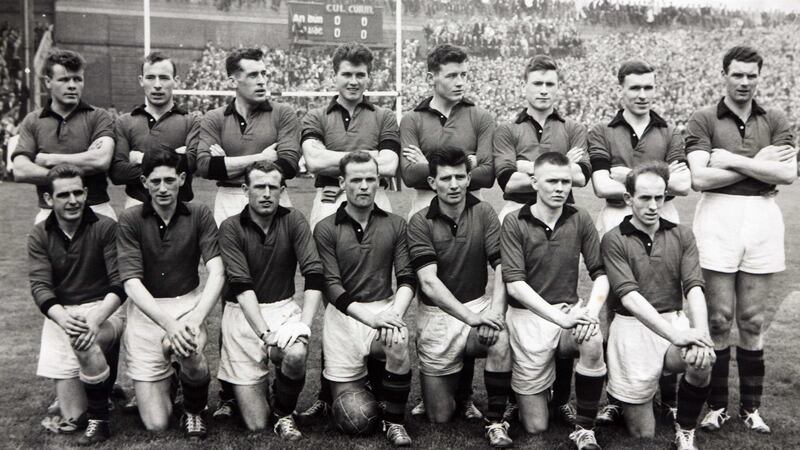BEFORE a table quiz at our club got underway last year, quizmaster John Otterson kept everyone entertained with some archive footage.
A BBC cameraman for the past 50 years, John’s attic contained a video of a challenge game between Glen and Omagh which was played in the 1980s. After the novelty of identifying various players wore off, another feature of the game quickly became apparent. It was totally and utterly awful. The standard was abysmal. It was like the teams were playing with blindfolds. Vast tracts of time would elapse before three passes were completed. That is not an exaggeration. It was really appalling.
Bear in mind, the players on the field were of a decent standard. Omagh won the Tyrone Championship in 1988 and the vast majority of the Glen team had played for St Patrick’s, Maghera or represented Derry at minor, U21 or senior level.
Before watching that DVD, I would have had a very different opinion about the standard of club football from that era. The video evidence provided a shocking reality check. The extent to which Gaelic football has improved was rammed home a few days later when I was at our pitch for an underage training session. On the same field where Omagh and Glen had played like drunk men (they probably were), a minor B Championship match was being held.
Compared to the video at the table quiz, the game was incredibly good. Everything was better – fitness levels, the speed of the play, the execution of basic skills, the ability to hold possession. After the horror show of Omagh and Glen, it was like watching football from a different planet. Yet, when I passed on this observation to a friend who was supporting one of the clubs, he bristled with indignation. After a stream of swear words, I was left in no doubt that he thought the football was terrible.
The same man, a lifelong GAA fanatic, contends that modern day county football is “unwatchable”. Of course, nearly all GAA men have a tendency to be overly nostalgic, particularly when looking back at the era when they played the game.
The dance-hall generation who punched the heads off each other at carnival matches are the worst offenders. According to them, not only sport, but civilisation reached its zenith during the ’60s. Celtic and Man United won the European Cup, Elvis was still alive and the great Down side put a smile on every Ulster Gael from Belfast to Belcoo.
Move forward a few years, and the sons of the ‘Carnival Men’ pine for the football of the early ’90s. As this decade pre-dated the blanket defence, they contend that the fitness of the teams, the greater emphasis on kick-passing and the long kick-outs created a spectacle that has yet to be surpassed.
It seems every fan has his own golden year. In more recent times, harking back to the good old days while constantly denigrating modern football has developed into a popular pastime. And that’s why it’s worth highlighting the disparity which exists between the misty-eyed romance and the hard, cold reality of the situation. Trust me, the video in your head is playing a different game to the one which actually took place.
The statistics will shock some people. For example, despite the fact there was no blanket defence in the 1960s or the 1990s, scoring averages have actually continued to rise.
The figures below shows the average number of points scored per game in the Ulster Championship in every decade after 1905 (When the average was more than 0.5 the score was rounded up):
Ulster SFC 1905: 14 points
Ulster SFC 1915: 15 points
Ulster SFC 1925: 16 points
Ulster SFC 1935: 20 points
Ulster SFC 1945: 27 points
Ulster SFC 1955: 20 points
Ulster SFC 1965: 24 points
Ulster SFC 1975: 25 points
Ulster SFC 1985: 23 points
Ulster SFC 1995: 26 points
Ulster SFC 2005: 29 points
Ulster SFC 2015 (so far): 28 points
When the last century is divided into blocks of 20 years, a very clear pattern emerges. The figures speak for themselves:
1905/1915/1925: 15 points
1935/1945/1955: 22 points
1965/1975/1985: 24 points
1995/2005/2015 (to date): 28 points
Evidently, this non-stop moaning about defensive football needs to be curtailed. At the very least, more kudos and respect must be given to the skill level of our current players.
It has never been harder to score in Gaelic football. Defenders are fitter and stronger. Tackling is more aggressive and effective. More players are deployed in defence and strategies are repeatedly employed which nullify the best forward in the opposition. Yet, the number of scores per game is higher than the so-called good old days.
The focus which is placed on negating rival teams is demonstrated in the snapshot of the dossier which was compiled on Monaghan. Against the Breeze received a copy of these profiles, which were compiled by an Ulster county.
The level of detail is illuminating. Ten years ago, county managers thought they were breaking new ground when they provided defenders with extensive analysis on the opposition’s best forward.
Nowadays, even defenders are subjected to microscopic analysis. If a forward can second guess what a defender is going to do, he has a better chance of forcing a turnover that could lead to the point that will win the game.
In the file compiled on Monaghan, the intelligence gatherer notes how Vinny Corey “always bounces the ball after getting possession”. Wing-back Karl O’Connell “likes to hand off opponents with his left arm,” while the right-handed and right-footed Dessie Mone is apparently “poor on his left hand side”. The advice given is to “attack this side at all times”.
It can be assumed that every county in Ulster produces similar player profiles. This level of detail isn’t the exception. It’s the rule.
Despite blanket defences and detailed player profiles, scoring averages remain extremely buoyant. Monaghan scored 1-20 last Sunday. Their victory over Fermanagh means they have qualified for their third Ulster final in-a-row. The last time Monaghan accomplished that feat was when they reached four successive finals between 1921 and 1924.
Food for thought. The 1924 final required a replay. The drawn game finished on the rather gruesome scoreline of Cavan 1-3 Monaghan 1-3. Cavan won the replay by a goal, 2-3 to 1-3.
And they say football’s not what it was.








